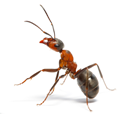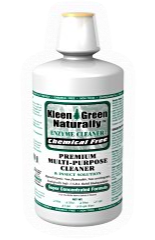- Home
- Fire Ants - Natural Ginesis
Fire Ants - Natural Ginesis



Fire Ant Facts
| Common Name | Scientific Name | TESTIMONIAL "Thank you. We seem to be rid of the bed bugs and the roaches also. HH - California |
| Black Imported Fire Ant |
Solenopsis richteri Forel | |
| Red Inported Fire Ant |
Solenopsis invicta Buren |
|
Two species of Imported Fire Ants (IFA) were accidentally introduced into the United States from South America at the port of Mobile, Alabama. The black imported fire ant, Solenopsis richteri Forel, arrived sometime around 1918 and the red imported fire ant, Solenopsis invicta Buren, in the late 1930's. Both species probably came to the port in soil used as ballast in cargo ships. Today, IFA infest more than 320,000,000 acres in Alabama, Arkansas, California, Florida, Georgia, Louisiana, Mississippi, New Mexico, North Carolina, Oklahoma, South Carolina, Tennessee, Texas, and Puerto Rico. IFA are a major public nuisance because of their ferocious sting and aggressive behavior, and also damage several agricultural commodities.
Fire ants look like ordinary ants, but their bodies and antennae are different. Their mounds can be more than 10 inches high, 15 inches in diameter and 3 feet deep. When disturbed they are aggressive and cause a painful singe that raises a small welt. Fire ants inflict a fiery sting, which causes a small blister or pustule to form at the site of each sting after several hours. The blisters become itchy while healing and are prone to infection if broken. |
Fire Ant Society
Fire ants normally spread by one of the following methods: seasonal relocations, migration in nursery stock, natural mating flights and during floods. They have developed a unique method to keep from drowning that also helps them spread their colonies. At first hint of rising water, worker ants gather the entire colony into a ball (sometimes as big as a basketball). As the water overtakes the mound, the ball rides the flood like a living raft, rolling in the water so all the members can take turns breathing. When they strike a solid object, be it a swimming dog or your canoe, they quickly swarm aboard.
Mating flights are the most natural way that fire ant colonies spread. Mating between the winged male and female ants (also called alates) takes place 300' to 800' in the air, usually in late spring or early summer. The males fly up first and wait for the females. After mating, the males die and the newly mated queens seek moist areas to start a new colony, normally within one mile of the mother colony. But these new queens can be blown by the wind up to 12 miles during mating flights! Once the female lands on a suitable moist site, she removes her wings, digs a small burrow in the soil and then seals it. Within 24 hours the queen begins laying eggs, normally only 10 - 15 in the first cluster. The queen ant can live up to 7 years and will produce up to 1,500 to 1,600 eggs per day throughout her life.
Fire ant workers are sterile females that range in size from .08 to .2 in length. The larger workers are called majors, the medium sized are called medias and the smallest size are called minors. A fire ant mound can contain 80,000 to over 250,000 workers. Disturbed or injured workers release alarm pheromones to the other ants. All of the workers can sting and inject venom that causes blisters and allergic responses, including possible anaphylactic shock.
Fire Ant Stings
About 5 million Americans are stung every year! In infested areas, fire ant stings occur more frequently than bee, wasp, hornet, and yellow jacket stings. Stepping on a fire ant mound is almost unavoidable, especially when walking in heavily infested areas. Furthermore, many mounds are not easily seen, with many lateral tunnels extending several feet away from the mound just beneath the soil surface. Ants defend these tunnels as part of their mound. More than 25,000 people each year seek medical attention for painful fire ant bites. The sting itself is usually not life-threatening but secondary infections can result. To prevent infection, do not scratch pustules and treat the sting with an insect bite remedy. Persons who are hypersensitive to the fire ant venom may experience symptoms such as nausea, dizziness or even shock or death. Individuals exhibiting such reactions to fire ant stings should see a physician immediately. About a dozen Americans die of their wounds each year.
A person who stops to stand on a mound, one of its tunnels, or who leans against a fence post included in the defended area, can have hundreds of ants rush out to attack. Typically, the ants can be swarming on a person for 10 or more seconds before they grab the skin with their mandibles, double over their abdomens, and inject their stingers. Multiple stings are why some people die!
Major fire ant problems do not occur in their native land where the fire ants fear phorid fly species that only live to torture and kill fire ants. Phorid flies are being currently evaluated in Gainesville, Florida. Although a single fire ant sting hurts less than a bee or wasp sting, the effect of multiple stings is impressive. Multiple stings are common, not only because hundreds of ants may have attacked, but because individual ants can administer several stings. Each sting usually results in the formation of a pustule within 6 to 24 hours. The majority of stings are uncomplicated, but secondary infections may occur if the pustule is broken, and scars may last for several months. Severe infections requiring skin grafting or amputation have been known to occur from fire ant stings. Some people experience a generalized allergic reaction to a fire ant sting. The reaction can include hives, swelling, nausea, vomiting and shock. People exhibiting these symptoms after being stung by fire ants should get medical attention immediately. Death can occur in hypersensitive, older, and very young people. Individuals who are allergic to fire ant toxins may require desensitization therapy.
If you are stung by a fire ant:
- Apply a cold compress to relieve the swelling and pain.
- Gently wash the affected area with soap and water and leave the blister intact.
- People who are allergic to insect stings should seek medical attention immediately.
- On rare occasions, fire ant stings can cause severe acute allergic reaction (anaphylaxis).
- First Aid: Try applying a mix of 1 oz of Kleen Green™ to 8 oz of water. Apply as often as needed to bite area.
Fire Ant Feeding Habits
Fire ants are omnivores and will eat plant and animal material including mice, turtles, snakes, other vertebrates, crops, plants, saplings, wildflowers, fruit and grass but they prefer other insects. They can destroy or damage crops such as soybeans, blueberries, peanuts, sunflowers, watermelons, cantaloupes, cucumbers, pecans, eggplant, corn, okra, strawberries, and potatoes by feeding directly on the plants and/or by protecting other insects that damage the crops. The fire ants may feed on plant seedlings and germinating seeds causing crop damages. They chew the bark and growing tips of citrus trees and feed on the fruit.
The oldest and most expendable 20% or so of the colonys fire ant workers leave the nest to search for food. They explore 50-100 feet from the nest with an efficient looping pattern. Although the worker ants can chew and cut with their mandibles, they can only swallow liquids. When they encounter liquid food in the field, they swallow it and carry it back to the nest. Solid food is cut to reasonable size and carried back to the nest. They prefer protein foods (insects and meats) but will feed virtually on everything including fruit, seeds, grease, butter, honeydew, plants, nuts, etc. Like other ants, fire ant workers share their food with their nest mates by regurgitating it so that it can be licked or sucked up as a liquid by other ants. In this way, most ants in the nest get fed equally. This food sharing is also why slow-acting poison baits can be an effective control tactic against fire ants. You can try using 1% or less borax or boric acid with 10% sucrose in water by ant colonies for 3 - 4 months (it may take that long to get control).
Severe Structural Damage
Because of their fiery stings and occasional news stories of livestock or people killed by multiple fire ant stings, people fear fire ants. In some areas infested with certain species of fire ants, lawns, school yards, river banks, athletic fields, mulched areas, compost piles, playgrounds, parks and picnic areas lie abandoned and unused because of the medical threat caused by the presence of fire ants. In campsites of state and national parks infested with fire ants, it is often difficult to put up or take down a tent without being stung by angry fire ants. They will storm anything that threatens their mound or that looks like food.
Fire ant mounds can interfere with farming and mowing operations by breaking equipment as well as turning ornamental turf and recreational fields into aesthetically disfigured moonscapes. Fire ants have caused sections of roads to collapse by removing huge amounts of soil from under the asphalt. They can nest in air conditioners, traffic lights and other electrical connections, often causing disruption of service. Increasingly, fire ants have also been found nesting in water meter casings, computers, television sets, wall voids, around plumbing and under carpeting in structures. Their presence inside can threaten pets, children and sleeping or bedridden people. You can usually quickly control them with diluted Kleen Green™ (read below the drench removal method and tips).
The ants have also been found invading and chewing on insulation on wiring and moving soil into these areas causing power failures in outdoor electrical equipment, apparently attracted (like many ants) to the electrical fields or impulses. Infested sites include household electric meters, air conditioning units, traffic signal control boxes, and even airport runway lights. Use clinically proven Perma-Guard Crawling Insect Control™ on wiring, insulation or any electrical equipment.
How to Remove Fire Ants With the Kleen Green™ Drench Removal Method
- Knock off the top of the fire ant mound (about 3 inches) to expose the much larger hole underneath the mound itself.
- Pour 1 cup of concentrated Kleen Green™ enzymes directly into the exposed hole.
- Follow by drenching (flooding) the mound with a garden hose for several minutes or pour at least 3 gallons of water directly into the mound.

Why and How Kleen Green™ Works
Insects are made up of a high concentration of protein. When Kleen Green is introduced to the insect, the enzymes act and can cause the insect to molt (shed its outer coating) prematurely. Poison pesticides attack the nervous system of the insect, which is not always effective. University research has noted that some insects have developed a resistance to poison based products. This revolutionary product is now available to the general consumer. Preformed enzymes have been used widely in restaurant and institutional settings for the last ten years, due to their low toxicity and superior cleaning properties. They are also becoming widely accepted in the field of pest cleaning as enzymes leave no toxic residues and the enzymatic effect on the insect exoskeleton is quick and safe. SAFE for Gardens, Plants, Ponds and around children and pets!
A Natural Alternative to Toxic Products
- Fast Acting
- Does Not Produce Toxic Fumes
- Extremely Economical
- More Effective and Safer than Pesticides!
Kleen Green: Non-Toxic, Pesticide Free Spray
Super Concentrated - Pesticide Free
- 8 oz makes 2 quarts
- 16oz makes 4 quarts
- 32oz makes 8 quarts
- 64 oz makes 16 quarts
- 128oz makes 32 quarts
- Also available in 5 gallons
THE MOST SUPERIOR NON-TOXIC REMEDY ON THE MARKET TODAY
| INGREDIENTS: Active ingredients: A specially formulated broad spectrum of NATURAL enzymes (protease, amylase, cellulose, lipase) derived from innocuous yeast strains. FDA good grade ingredients. GRAS (FDA Generally Regarded As Safe) List Parts 184 and 186. This product is not a pesticide. |
How to use Kleen Green™ Enzymes
- This nontoxic product provides superior cleaning in the entire home eradicating and digesting dirt, bacteria and microscopic mites - even dust mites.
- Spray and/or mist cracks, crevices, around window and door frames daily for several days. Persistence and patience will give the best results when using Kleen Green. No need to leave your home like that with pesticides. Kleen Green does not produce any toxic fumes. Kleen Green Enzymes eliminates offensive odors.
- Safe to spray on all surfaces: carpet, bedding, walls, floors and furniture.
- Kleen Green may be used in the laundry and in carpet cleaning machines.
- Pour 1oz. of concentrate directly into wash load without detergent for a fresh clean laundry.
- TIP: Kleen Green is safe to use in humidifiers. Pour 2 to 4 oz. into your humidifier for eliminating odors and controlling air born bacteria, germs and pests.
Tips for Fire Ant Removal
- The queen ant will tunnel and burrow down to the bottom of the mound, then climb back up about 1/3 of the way and take residence on a ledge at a 90 degree turn. Make sure the mound is thoroughly drenched with Kleen Green™. Your objective is to remove the queen!
- It is best to treat early in the morning. Fire ants move slower early in the morning, but are very active and fast in the afternoon. Fire ant workers also compensate for changing conditions (temperature and humidity) by moving the larvae and queen to more suitable locations within the mound. On cool mornings in the summer, the queens are easier to kill with the drench method because they are near the top of the mounds where it is warmer but as the day heats up the queens go deeper into the soil.
- The mound drench removal method is most effective after rains when the ground is wet and the ants have moved up into the drier soil in the mound. During excessively dry weather, effectiveness of the treatment may be enhanced if you soak the soil around the mound with plain water or diluted Kleen Green™.
- Talcum powder, medicated body powder or naphthalene will control and repel fire ants. Caulk, fill or seal off any openings into your building. You can also use WD-40 or vacuum up fire ants where it is not safe to use water sprays, foam, steam or carbon dioxide.
- Once a natural enemy or pathogen is introduced to a small area, it spreads quickly on its own - thus no professional from the poison industry wants to develop these extremely safe and effective pest controls because there is no profit incentive. Infestation can be expected again every 6 months.
- Queens are the first to be fed proteins, so any fire ant bait has to be protein-based. Fire ants feed on honeydew, sugars, proteins, oils, seeds, plants and insects. Fire ants frequently enter and nest in houses and are attracted to water and electrical wires and their associated magnetic fields or impulses. Locate ant activity inside by watching the ant trail and follow back to the void and treat with ant bait, Perma-Guard Crawling Insect Control™ and/or diluted Kleen Green™ enzymes (2 oz of Kleen Green™ to 32 oz of water).
Disclaimer
All Natural Ginesis products are safe and non-toxic when used as directed. Natural Ginesis is not a substitute for medical advice. The operators of this website and those who provide information for this site do not directly or indirectly practice medicine or dispense medical advice or services through this website. You should not rely on this information to determine a diagnosis or course of treatment, nor should it be considered a replacement for consultation with a physician or other certified healthcare provider. Natural Ginesis and its distributors do not make representations or warranties with respect to any information offered or provided on or through any company web sites regarding treatment, action or application of product. Neither Natural Ginesis nor any of its divisions or contributors shall have any liability for the content, errors or omissions in the information provided by this web site. Neither Natural Ginesis nor its distributors are responsible or liable for any advice, course of treatment, diagnosis, or any other information, services or products that you obtain through this site. Those with health problems, pregnancy or who are nursing are specifically advised that they should consult their physician before taking any nutritional supplement.
Thank You!
 Loading... Please wait...
Loading... Please wait...






 South Africa
South Africa